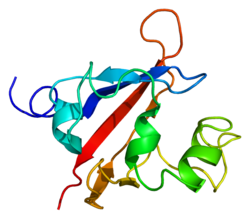- PASK
-
For the airport in Alaska with ICAO code PASK, see Selawik Airport.
PAS domain containing serine/threonine kinase 
PDB rendering based on 1ll8.Available structures PDB 1LL8, 3DLS Identifiers Symbols PASK; DKFZp434O051; DKFZp686P2031; KIAA0135; PASKIN; STK37 External IDs OMIM: 607505 MGI: 2155936 HomoloGene: 9038 GeneCards: PASK Gene EC number 2.7.11.1 Gene Ontology Molecular function • nucleotide binding
• protein serine/threonine kinase activity
• signal transducer activity
• protein binding
• ATP binding
• identical protein bindingCellular component • cytoplasm
• Golgi apparatusBiological process • regulation of transcription, DNA-dependent Sources: Amigo / QuickGO RNA expression pattern 

More reference expression data Orthologs Species Human Mouse Entrez 23178 269224 Ensembl ENSG00000115687 ENSMUSG00000026274 UniProt Q96RG2 Q8CEE6 RefSeq (mRNA) NM_015148 NM_080850.2 RefSeq (protein) NP_055963 NP_543126.2 Location (UCSC) Chr 2:
242.05 – 242.09 MbChr 1:
95.21 – 95.24 MbPubMed search [1] [2] PAS domain-containing serine/threonine-protein kinase is an enzyme that in humans is encoded by the PASK gene.[1][2][3][4]
PAS domains regulate the function of many intracellular signaling pathways in response to both extrinsic and intrinsic stimuli. PASK is an evolutionarily conserved protein present in yeast, flies, and mammals.[supplied by OMIM][4]
References
- ^ Hofer T, Spielmann P, Stengel P, Stier B, Katschinski DM, Desbaillets I, Gassmann M, Wenger RH (Nov 2001). "Mammalian PASKIN, a PAS-serine/threonine kinase related to bacterial oxygen sensors". Biochem Biophys Res Commun 288 (4): 757–64. doi:10.1006/bbrc.2001.5840. PMID 11688972.
- ^ Rutter J, Michnoff CH, Harper SM, Gardner KH, McKnight SL (Aug 2001). "PAS kinase: an evolutionarily conserved PAS domain-regulated serine/threonine kinase". Proc Natl Acad Sci U S A 98 (16): 8991–6. doi:10.1073/pnas.161284798. PMC 55361. PMID 11459942. http://www.pubmedcentral.nih.gov/articlerender.fcgi?tool=pmcentrez&artid=55361.
- ^ da Silva Xavier G, Rutter J, Rutter GA (Jun 2004). "Involvement of Per-Arnt-Sim (PAS) kinase in the stimulation of preproinsulin and pancreatic duodenum homeobox 1 gene expression by glucose". Proc Natl Acad Sci U S A 101 (22): 8319–24. doi:10.1073/pnas.0307737101. PMC 420392. PMID 15148392. http://www.pubmedcentral.nih.gov/articlerender.fcgi?tool=pmcentrez&artid=420392.
- ^ a b "Entrez Gene: PASK PAS domain containing serine/threonine kinase". http://www.ncbi.nlm.nih.gov/sites/entrez?Db=gene&Cmd=ShowDetailView&TermToSearch=23178.
Further reading
- Nakajima D, Okazaki N, Yamakawa H, et al. (2003). "Construction of expression-ready cDNA clones for KIAA genes: manual curation of 330 KIAA cDNA clones". DNA Res. 9 (3): 99–106. doi:10.1093/dnares/9.3.99. PMID 12168954.
- Nagase T, Seki N, Tanaka A, et al. (1996). "Prediction of the coding sequences of unidentified human genes. IV. The coding sequences of 40 new genes (KIAA0121-KIAA0160) deduced by analysis of cDNA clones from human cell line KG-1". DNA Res. 2 (4): 167–74, 199–210. doi:10.1093/dnares/2.4.167. PMID 8590280.
- Andersson B, Wentland MA, Ricafrente JY, et al. (1996). "A "double adaptor" method for improved shotgun library construction". Anal. Biochem. 236 (1): 107–13. doi:10.1006/abio.1996.0138. PMID 8619474.
- Yu W, Andersson B, Worley KC, et al. (1997). "Large-scale concatenation cDNA sequencing". Genome Res. 7 (4): 353–8. doi:10.1101/gr.7.4.353. PMC 139146. PMID 9110174. http://www.pubmedcentral.nih.gov/articlerender.fcgi?tool=pmcentrez&artid=139146.
- Ceulemans H, Van Eynde A, Pérez-Callejón E, et al. (1999). "Structure and splice products of the human gene encoding sds22, a putative mitotic regulator of protein phosphatase-1". Eur. J. Biochem. 262 (1): 36–42. doi:10.1046/j.1432-1327.1999.00344.x. PMID 10231361.
- Amezcua CA, Harper SM, Rutter J, Gardner KH (2003). "Structure and interactions of PAS kinase N-terminal PAS domain: model for intramolecular kinase regulation". Structure 10 (10): 1349–61. doi:10.1016/S0969-2126(02)00857-2. PMID 12377121.
- Strausberg RL, Feingold EA, Grouse LH, et al. (2003). "Generation and initial analysis of more than 15,000 full-length human and mouse cDNA sequences". Proc. Natl. Acad. Sci. U.S.A. 99 (26): 16899–903. doi:10.1073/pnas.242603899. PMC 139241. PMID 12477932. http://www.pubmedcentral.nih.gov/articlerender.fcgi?tool=pmcentrez&artid=139241.
- Ota T, Suzuki Y, Nishikawa T, et al. (2004). "Complete sequencing and characterization of 21,243 full-length human cDNAs". Nat. Genet. 36 (1): 40–5. doi:10.1038/ng1285. PMID 14702039.
- Beausoleil SA, Jedrychowski M, Schwartz D, et al. (2004). "Large-scale characterization of HeLa cell nuclear phosphoproteins". Proc. Natl. Acad. Sci. U.S.A. 101 (33): 12130–5. doi:10.1073/pnas.0404720101. PMC 514446. PMID 15302935. http://www.pubmedcentral.nih.gov/articlerender.fcgi?tool=pmcentrez&artid=514446.
- Gerhard DS, Wagner L, Feingold EA, et al. (2004). "The status, quality, and expansion of the NIH full-length cDNA project: the Mammalian Gene Collection (MGC)". Genome Res. 14 (10B): 2121–7. doi:10.1101/gr.2596504. PMC 528928. PMID 15489334. http://www.pubmedcentral.nih.gov/articlerender.fcgi?tool=pmcentrez&artid=528928.
- Ewing RM, Chu P, Elisma F, et al. (2007). "Large-scale mapping of human protein-protein interactions by mass spectrometry". Mol. Syst. Biol. 3 (1): 89. doi:10.1038/msb4100134. PMC 1847948. PMID 17353931. http://www.pubmedcentral.nih.gov/articlerender.fcgi?tool=pmcentrez&artid=1847948.
- Eckhardt K, Troger J, Reissmann J, et al. (2007). "Male germ cell expression of the PAS domain kinase PASKIN and its novel target eukaryotic translation elongation factor eEF1A1". Cell. Physiol. Biochem. 20 (1–4): 227–40. doi:10.1159/000104169. PMID 17595531.
- Kikani CK, Antonysamy SA, Bonanno JB, et al. (2010). "Structural bases of PAS domain-regulated kinase (PASK) activation in the absence of activation loop phosphorylation". J. Biol. Chem. 285 (52): 41034–43. doi:10.1074/jbc.M110.157594. PMID 20943661.
PDB gallery Categories:- Human proteins
- Cell signaling
- Signal transduction
- Chromosome 2 gene stubs
Wikimedia Foundation. 2010.

